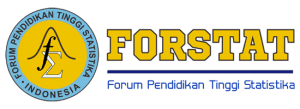PENGGUNAAN SELF ORGANIZING MAP DALAM PENGELOMPOKAN TINGKAT KESEJAHTERAAN MASYARAKAT
Abstract
Keywords
Full Text:
PDFReferences
Anis, Yunus, dan Isnanto R.R. 2014. Penerapan Metode Self-Organizing Map (SOM) untuk Visualisasi Data Geospasial Pada Informasi Sebaran Data Pemilih Tetap (DPT). Jurnal Sistem Informasi Bisnis. Vol.01.
Annas, S., Kanai, T., & Koyama, S. 2007. Principal Component Analysis and Self-Organizing Map dor Visualizing and Classifying Fire Risks in Forest Regions. Jurnal Agricultural Information Reseach. Vol.16, No.2. Halaman: 44-51.
Badan Pusat Statistik Provinsi Sulawesi Selatan, 2018. Statistik Kesejahteraan Rakyat Provinsi Sulawesi Selatan Tahun 2018. Badan Pusat Statistik Provinsi Sulawesi Selatan.
Cahyani, A. D., Putro, S. S., Rahmawati, L. 2013. Pemandaatan Metode Cluster SOM-IDB sebagai Analisa Pengelompokan Penerima Beasiswa. https://docplayer.info/29552003-Pemanfaatan-metode-cluster-som-idb-sebagai-analisa-pengelompokan-penerima-beasiswa.html. diakses pada tanggal 16 Maret 2019.
Davies, D., & Bouldin, D. 1979. A Cluster Separation Measure. IEEE Transactions on Pattern Analysis and Machine Intelligence PAMI-1(2):224 - 227
Hariadi. 2007. Klasifikasi Kekerapan Kunjungan Lokasi Berbasis Location Based Service (LBS) menggunakan Self-Organizing Map (SOM). Tesis. Institut Teknologi Sepuluh Nopember.
Irwan. 2010. Penggunaan Analisis Diskriminan dan Self-Organizing Maps (SOM) dalam Pengelompokan Objek (Studi Penglompokan Desa Miskin di Kabupaten Wajo). Skripsi UNM. Makassar
Shieh, S., & Liao, I. 2012. A New Approach for Data Clsutering and Visualization Using Self-Organizing Map. International Journal of Expert System with Application. Vol 39, issue 15.
Siang, J. 2009. Jaringan Syaraf Tiruan dan Pemogramannya Menggunakan Matlab (Ed.II). Yogyakarta: Andi Offset.
Supranto, J. 2004. Analisis Multivariat Arti dan Interpretasi Edisi Pertama. Jakarta: PR Rineka Cipta.
DOI: https://doi.org/10.34312/jjps.v1i2.7266
Refbacks
- There are currently no refbacks.
Copyright (c) 2020 Jambura Journal of Probability and Statistics

This work is licensed under a Creative Commons Attribution-NonCommercial 4.0 International License.







.jpg)






